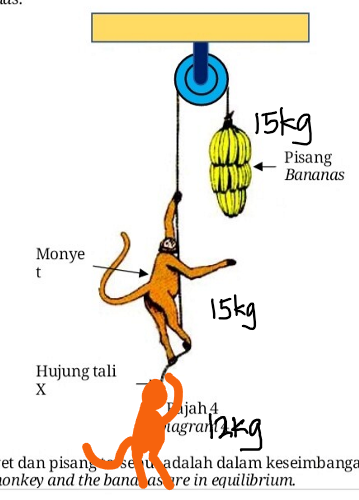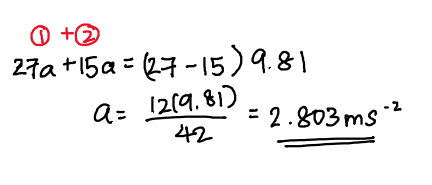Question
4 Rajah 4 menunjukkan seekor monyet yang sedang memegang dengan kuat
seutas tali ringan yang merentasi sebuah takal tanpa geseran dan dikat
dengan setandan pisang yang berjisim 15 kg.
Diagram 4 shows a monkey has a firm hold on a light rope that passes
over a frictionless pulley and is attached to a 15 kg bunch of bananas.
Monyet dan pisang tersebut adalah dalam keseimbangan.
The monkey and the bananas are in equilibrium.(d) Seekor monyet yang lain yang berjisim 12 kg ternampak pisang
tersebut dan melompat mendekati pisang dan memegang hujung tali
X. Apakah yang akan terjadi dengan pergerakan kedua-dua monyet
tersebut?
Another monkey of mass 12 kg saw the bananas, and jump towards
the bananas and hold the end of the rope X. What happened to the
motion of both monkeys?(e) Hitungkan
Calculate
(i) pecutan sistem itu
acceleration of the system
(ii) ketegangan tali.
the tension of the rope.
Answer
Hi Farhaini,
For part (e), I think the question is a follow-up from (d). Because without the second monkey, there would be no acceleration as the system is in equilibrium.
So using the description from (d), this is what the diagram should look like.
(excuse my not so good drawing skills  )
)

If we want to simplify this diagram, we can imagine the monkeys as 12kg and 15kg masses, and the banana as another 15kg mass on the other side of the pulley.

Weight always acts downwards, so that’s not a problem. And since the string is attached above the “masses” on both sides, the tension (pulling force) will act upwards, because we don’t use strings to push but to pull things. For this case, tension will be the same on both sides because it is the same string. By logic, the heavier side (monkeys) will move downwards, and the lighter side (banana) will move upwards. The system is not in equilibrium anymore.

If this is still too complicated, we can break it down into two separate diagrams for clarity.
Since we know the side with the heavier mass moves downwards, then that means the weight of the monkeys, W_1 must be greater than the tension to produce a resultant force that acts downwards. Let M = 12kg + 15kg = 27kg, resultant force = Ma

On the right, the opposite happens. Since the motion is upwards, the resultant force acts upwards. Tension must be greater than the weight of the banana, W_2, for the banana to move upwards. Let m = 15kg, resultant force = ma

The question wants the acceleration to be found first, so we eliminate T to find a.

Substituting a into either one of the two previous equations gives us T.

Hope this helps! 
Thank you very much ! I understood🤩


